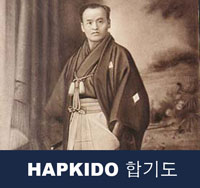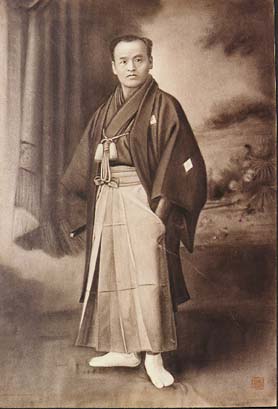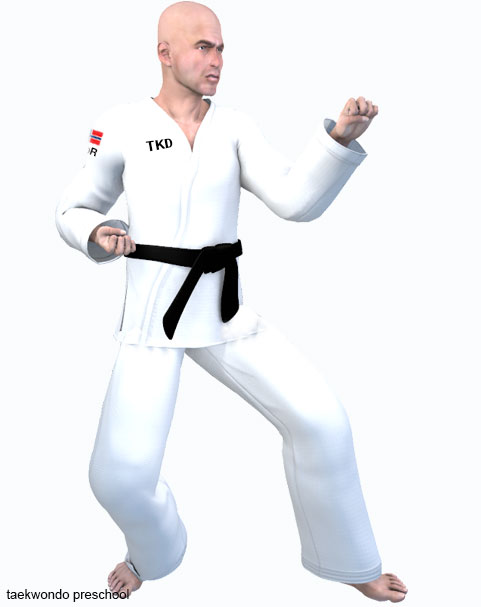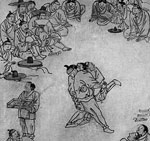Taekwondo 태권도Taekwondo Preschool
Korean martial arts are military practices and methods which have their place in the history of Korea but have been adapted for use by both military and non-military personnel as a method of personal growth or recreation.

Hapkido 합기도
Korean martial arts are military practices and methods which have their place in the history of Korea but have been adapted for use by both military and non-military personnel as a method of personal growth or recreation.
Hapkido (also spelled hap ki do or hapki-do; Hangul: 합기도; Hanja: 合氣道) is a dynamic and highly eclectic Korean martial art. It is a form of self-defense that employs joint locks, grappling and throwing techniques of other martial arts, as well as kicks, punches, and other striking attacks. There is also the use of traditional weapons, including knife, sword, rope, jool bong (nunchaku), cane, short stick (dan bong), and middle length staff (joong bong, gun, bō (Japanese)) which vary in emphasis depending on the particular tradition examined.
Hapkido contains both long- and close-range fighting techniques, utilizing jumping kicks and percussive hand strikes at longer ranges and pressure point strikes, joint locks, or throws at closer fighting distances. Hapkido emphasizes circular motion, redirection of force, and control of the opponent. Practitioners seek to gain advantage through footwork and body positioning to incorporate the use of leverage, avoiding the use of strength against strength.
The art adapted from Daitō-ryū Aiki-jūjutsu (大東流合気柔術) as it was taught by Choi Yong-Sool (Hangul: 최용술) when he returned to Korea after World War II, having lived in Japan for 30 years. This system was later combined with kicking and striking techniques of indigenous and contemporary arts such as taekkyeon, as well as throwing techniques and ground fighting from Japanese Judo. Its history is obscured by the historical animosity between the Korean and Japanese people following the Second World War.
Name
Hapkido is rendered in the native Korean writing system known as hangul, the script used most widely in modern Korea. The art's name can also however be written "合氣道" utilizing the same traditional Chinese characterswhich would have been used to refer to the Japanese martial art of aikido in the pre-1946 period. The current preference in Japan is for the use of a modern simplified second character; substituting 気 for the earlier, more complex character 氣.
The character hap means "coordinated" or "joining" ki describes internal energy, spirit, strength, or power; and do means "way" or "art", yielding a literal translation of "joining-energy-way". It is most often translated as "the way of coordinating energy", "the way of coordinated power" or "the way of harmony".
Although aikido and hapkido are believed by many to share a common history, they remain separate and distinct from one another. They differ significantly in philosophy, range of responses and manner of executing techniques. The fact that they share the same original Chinese characters, despite being pronounced "ai" in Japanese and "hap" in Korean, has proved problematic in promoting the art internationally as a discipline with its own set of unique characteristics differing from those of the Japanese art.
History and major figures from Korea
The birth of modern hapkido can be traced to the efforts of a group of Korean nationals in the post Japanese colonial period of Korea, Choi Yong-Sool (1904–1986) and his most prominent students; Seo Bok-Seob, the first student of the art; Ji Han-Jae (born 1936), one of the earliest promoters of the art; Kim Moo-Hong, a major innovator; Myung Jae-Nam, a connector between the art of hapkido and aikido, Myung Kwang-Sik the historian and ambassador, all of whom were direct students of Choi or of his immediate students.
Choi Yong-Sool
For the main article see Choi Yong-Sool

Choi Yong-Sool (Hangul: 최용술)'s training in martial arts is a subject of contention. It is known that Choi was sent to Japan as a young boy and returned to Korea with techniques characteristic of Daitō-ryū Aiki-jūjutsu (大東流合気柔術), a forerunner of aikido. The next portion of the story is quite controversial in Daitō-ryū circles but is claimed by many contemporary hapkido-ists and is attributed to Choi in an interview (released posthumously) that took place during a trip Choi made to the United States in 1980 to visit his second direct lineage successor Chinil Chang in New York City.
In the interview with Chinil Chang, Choi claims to have been adopted by Takeda Sōkaku when he was 11 years old and was given the Japanese name, Yoshida Asao. He claims to have been taken to Takeda's home and dojo in Akita on Shin Shu mountain where he lived and trained with the master for 30 years. The interview also asserts that he travelled with him as a teaching assistant, that he was employed to catch war deserters and that he was the only student to have a complete understanding of the system taught by Takeda.
This is contradicted by other claims asserting that Choi was simply a worker in the home of Takeda. The meticulous enrollment and fee records of Tokimune Takeda, Takeda's eldest son and Daitō-ryū's successor, do not seem to include Choi's name among them. Therefore, except for claims made by Choi himself, there is little evidence that Choi was the adopted son of Takeda, or that he ever formally studied Daitō-ryū under the founder of the art.
Stanley Pranin, then of Aiki News and now editor of the Aikidojournal.com, asked Kisshomaru Ueshiba about Choi Yong-Sool and hapkido:
On another subject, it is true that a Korean named "Choi" who founded hapkido studied aikido or Daito-ryu?
I don't know what art it was but I understand that there was a young Korean of about 17 or 18 who participated in a seminar of Sokaku Takeda Sensei held in Asahikawa City in Hokkaidō. It seems that he studied the art together with my father and would refer to him as his "senior".If that's the case the art must have been Daito-ryu.
I've heard that this man who studied Daito-ryu had some contact with my father after that. Then he returned to Korea and began teaching Daito-ryu on a modest scale. The art gradually became popular and many Koreans trained with him. Since aikido became popular in Japan he called his art hapkido [written in Korean with the same characters as aikido]. Then the art split into many schools before anyone realized it. This is what my father told me. I once received a letter from this teacher after my father's death.
Some argue that Choi Yong-Sool's potential omission from the records, and the ensuing debate over hapkido's origins, may be due to tensions between Koreans and Japanese, partly as a result of the Japanese occupation of Korea. At the height of dispute, it is claimed by hapkido practitioners that Koreans were excluded from listing, though this is contradicted by Takeda's records which contain other Korean names. While some commentators claim hapkido has a Japanese lineage, others state that its origins lay with indigenous Korean martial arts.
Choi Yong-Sool's first student, and the man whom some claim helped him develop the art of hapkido was Seo Bok-Seob, a Korean judo black belt when they met. Some of Choi's other respected senior students are: Chinil Chang, Ji Han-Jae, Chung Kee Tae, Kim Moo-Hong, and arguably Suh In-Hyuk (Hangul: 서인혁) and Lee Joo-Bang (Hangul: 이주방) who went on to form the arts of Kuk Sool Won and modern Hwa Rang Do respectively (though some argue that their training stems from time spent training under Kim Moo-Hong).
Seo Bok-Seob
For the main article see Seo Bok-Seob
Choi's first student and the first person known to have opened up a dojang under Choi was Seo Bok-Seob (also spelled Suh Bok-Sup; Hangul: 서복섭).
In 1948, when Seo Bok-sub was still in his early 20s, he had already earned his black belt in judo and was a graduate of Korea University. After watching Choi Yong-Sool successfully defend himself against a group of men when an argument erupted in the yard of the Seo Brewery Company, Seo who was son of the chairman of the company, invited Choi to begin teaching martial arts to him and some workers at the distillery where he had prepared a dojang.
In 1951, Seo opened up the first proper dojang called the "Daehan Hapki Yu Kwon Sool Dojang (Hangul: 대한 합기 유권술 도장)". The first symbol, designed by Seo, which was used to denote the art was the inverted arrowhead design featured in both the modern incarnation of the KiDo Association and by Myung Kwang-Sik's World Hapkido Federation. Choi Yong-Sool was also employed during this time as a bodyguard to Seo's father who was a congressman. Seo and Choi agreed to shorten the name of the art from 'hapki yu kwon sool' to 'hapkido' in 1959.
Chinil Chang
A direct student of Choi, Chinil Chang inherited the title of Doju in Choi's personal and complete system of Hapkido on January 15, 1985, becoming the second direct lineage Grandmaster.
On April 5, 1985 Choi personally awarded Chang the only existing 10th Dan certificate in Hapkido history. Chang also had the privilege and honor of being the first Hapkido master awarded the 9th Dan certificate by Choi in 1980.
A large inauguration ceremony followed on April 11, 1985. The historic event was covered and documented by Korea Sports News and MBC Korean Television. Choi Young-sool, Chang, and Choi's son, the late Choi Bok-Yeol, were in attendance. Chang is the only Hapkido master ever awarded the 10th Dan and Doju title directly from Choi. Choi left the full documentation and recordings of the system to Chang, who continued to research and document the full history and development of Hapkido.
Furthermore, the future Grandmaster, who was a personally trained, closed-door disciple of Choi, was given Letter of Appointment certificates, the second dated December 1, 1977 and the third dated March 5, 1980. This gave Chang more progressive power and authority in Choi's Hapkido Association. These specific certificates, along with his 9th Dan ranking in 1980, and 10th Dan ranking in 1985, amply demonstrate that Choi was grooming Chang to be the future Grandmaster of Hapkido
Chang's intimate video interview with his teacher Doju Choi during his visit to New York City has been abused through numerous interpretations and translations. Some have even claimed erroneously to have conducted the interview themselves, further clouding and distorting the truth and gravity inherent in the interview. These endless distortions were generally rebutted in various media each time they appeared.
Doju Chang continues to teach in New York City after decades of maintaining a commercial school, as well as a stint teaching Hapkido at the United Nations. He currently teaches a small group in NYC dedicated to the preservation of Hapkido. Many detractors have spread endless conjecture about him. One lineage created further controversy by stating Choi passed the system to his only son, Choi Bok-Yeol, which is incorrect, misleading, and insulting to the legacy and wishes of Choi. Black Belt Magazine, respecting Chinil Chang as the second lineage successor, asked him to write a brief obituary on Choi that appeared in the April 1987 issue.
Ji Han-Jae
For the main article see Ji Han-Jae
Ji Han-Jae (Hangul: 지한재) was undoubtedly the prime mover in the art of Korean hapkido. It is due to his physical skills, technical contributions, promotional efforts and political connections as head hapkido instructor to the presidential body guard under Korean President Park Jeong-Hee (Hangul: 박정희) that hapkido became popularized, first within Korea and then internationally.
If the martial art education of Choi Yong-Sool is unconfirmed, the same must be said for martial art history of Ji Han-Jae's training, apart from his time as a student of Choi. Ji was an early student (Dan #14) of Choi. He details that prior to opening his martial art school in Seoul, the Sung Moo Kwan (Hangul: 성무관), he also supposedlly studied from a man known as 'Taoist Lee' and an old woman he knew as 'Grandma'.
As a teacher of hapkido, Ji incorporated traditional Korean kicking techniques (from Taoist Lee and the art Sam Rang Do Tek Gi) and punching techniques into the system and gave the resulting synthesis the name hapkido in 1957. Hapkido is the Korean pronunciation of (Japanese) aikido and is sometimes erroneously referred to as its Korean cousin.
Although a founding member of the Dae Han Ki Do Hwe (Korea Kido Association) in 1963 with Choi Yong-Sool as titular Chairman and Kim Jeong-Yoon as Secretary General and Head Instructor for the association Ji found himself not able to exert as much control over the organization as he might have wished. To this end and with the support of the Head of the Security Forces, Park Jong-Kyu, Ji founded the very successful Korea Hapkido Association (Dae Han Hapkido Hyub Hwe; Hangul: 대한 합기도 협회) in 1965.
Later when this organization combined with the organizations founded by Myung Jae-Nam (Korea Hapki Association/Hangook Hapki Hwe; Hangul: 한국 합기회) and Kim Moo-Hong (Korean Hapkido Association/Hangook Hapkido Hyub Hwe; Hangul: 한국 합기도 협회) in 1973 they became the very extensive and influential organization known as the Republic of Korea Hapkido Association (Dae Han Min Gook Hapkido Hyub Hwe; Hangul: 대한민국 합기도 협회).
In 1984, after being released from prison for fraud, Ji moved first to Germany and then to the United States and founded Sin Moo Hapkido (Hangul: 신무 합기도), which incorporates philosophical tenets, a specific series of techniques (including kicks) and healing techniques into the art. Two of Ji Han-Jae's notable students in Korea were Kwon Tae-Man (Hangul: 권태만), Myung Jae-Nam (Hangul: 명재남). Ji can be seen in the films Lady Kung-fu and Game of Death in which he takes part in a long fight scene against Bruce Lee.
After the death of Choi Yong-Sool in 1986, Ji came forward with the assertion that it was he who founded the Korean art of hapkido, asserting that Choi Yong-Sool taught only yawara based skills and that it was he who added much of the kicking, and weapon techniques we now associate with modern hapkido. He also asserts that it was he that first used the term 'hapkido' to refer to the art. While both claims are contested by some of the other senior teachers of the art, what is not contested is the undeniably huge contributions made by Ji to the art, its systematization and its promotion world wide.
Kim Yun-Sik
For the main article see Kim Yun-Sik
Kim Yun-Sik was born in Seoul, South Korea in 1943. He is one of the highest ranking (10th dan) Hapkido instructors in the world and founder of Bum Moo Kwan Hapkido. He began his martial arts training in 1954 under the direction of Choi Yong-Sool, and received the black belt from Choi in 1957. In the same year he received the black belt in taekwondo from Grandmaster Hwang Kee.
Kim is the founder of the Bum Moo Kwan style, in which the practitioner is instructed to finish the encounter quickly, using any available material as weapon or any part of his body, aiming the opponent's pressure or vital points. Bum Moo is one of the three original and government regulated Hapkido Kwans. Residing, teaching and training in Brazil since 1977, Kim was the master of several Hapkido World Champions, such as Leandro Heck Gemeo and Norberto Serrano Jr.
Han Bong-Soo
For the main article see Han Bong-Soo
Han Bong-Soo began his training in Hapkido after going to see a demonstration put on by the founder, Yong Sul Choi. From then on, he committed himself to Hapkido training under Choi. Han Bong-Soo (Hangul: 한봉수) was the world's foremost practitioner of Hapkido, and is referred to as the Father of Hapkido in the Western World. As one of the original senior students of Yong Sul Choi, he led a dedicated effort in the development of Hapkido as it is known today. He taught thousands of loyal students throughout his life with many becoming masters themselves. Other masters across all styles have sought out his wisdom and teachings.
In 1967, Han emigrated to the United States of America, first staying with and teaching at his friend S. O. Choi's hapkido school in California. Han later opened his own school in Los Angeles in 1968. His early years were difficult and he worked in a factory during the day while he taught at a struggling hapkido school in the evening located in an economically depressed area. Later, he relocated his school to the Pacific Palisades area in an effort to be closer to Hollywood and the movie industry.
On July 4, 1969, Han Bong Soo was giving a demonstration of Hapkido at a park in Pacific Palisades, California. In the audience was Tom Laughlin. After a spectacular demonstration, Laughlin approached Han about being involved in a movie project called Billy Jack. Han gained critical acclaim for staging and performing some of the most realistic martial arts fight sequences in a film. Before Billy Jack, movies contained at most brief references to martial arts, with fights portrayed by actors who had little training. With Billy Jack, Han introduced authentic hapkido techniques to Western audiences. In its sequel, The Trial of Billy Jack, he received a co-starring part where he spoke about and demonstrated the art, mentioning the art by name for the first time.
Han has been the subject of many magazine and newspaper articles, martial arts magazine cover stories, and was a member of the Black Belt Magazine Hall of Fame in 1978 and the Martial Arts History Museum Hall of Fame in 1999. He was also featured in the A&E documentary, The Martial Arts and the Wesley Snipes-produced Master of the Martial Arts.
In addition to being cited in dozens of martial arts books, he wrote many articles on the Way of martial arts, and also authored the book, Hapkido, The Korean Art of Self-Defense, that was published by Ohara Publications in 1974, which is now in its 23rd printing. He completed a series of ten instructional Hapkido DVDs which are in worldwide distribution.
Han studied and refined this Korean martial art for more than 60 years. Up to the time of his death, in 2007, he held the rank of 9th Dan Black Belt. Han upheld that the 10th Dan rank was to be reserved for Yong Sul Choi. He founded and presided over the International Hapkido Federation.
Kim Moo-Hong
For the main article see Kim Moo Hong
A student from the Choi and Seo's Daehan Hapki Yu Kwon Sool Dojang, was Kim Moo-Hong (Hangul: 김무홍), who later taught at Seo's Joong Ang dojang (Hangul: 중앙 도장) in Daegu. Seo, who promoted Kim to 4th degree, credits Kim with the development of many kicks which are still used in hapkido today. Kim apparentally took the concepts from very basic kicks he had learned from Choi and went to a temple to work on developing them to a much greater degree. Later, in 1961, Kim travelled to Seoul and while staying at Ji Han-Jae's Sung Moo Kwan dojang they finalized the kicking curriculum.
Kim went on to found his Shin Moo Kwan dojang (Hangul: 신무관 도장) in the Jongmyo section of Seoul, also in 1961. Won Kwang-Hwa (Hangul: 원광화) also served as an instructor at this dojang. Kim's notable students were Lee Han-Cheol (Hangul: 이한철), Kim Woo-Tak (Hangul: 김우탁; who founded the Kuk Sool Kwan Hapkido dojang), Huh Il-Woong (Hangul: 허일웅), Lee Joo-Bang (Hangul: 이주방; who founded modern Hwa Rang Do), Na Han-Dong (Hangul: 나한동), Shin Dong-Ki (Hangul: 신동기) and Seo In-Hyuk (Hangul: 서인혁; who founded Kuk Sool Won).
Originally a member of the Korea Kido Association, the organization sent Kim to teach hapkido in the United States in 1969. Upon returning to Korea in 1970, Kim looked to Ji Han-Jae's move to set up his own organization and with the encouragement of his students followed suit and founded the Korean Hapkido Association (Hangook Hapkido Association) in 1971. Later he combined this organization with the groups led by Ji Han-Jae and Myung Jae-Nam to form the Republic of Korea Hapkido Association.
Myung Jae-Nam
For the main article see Myung Jae-Nam
In 1972, Myung Jae-Nam (Hangul: 명재남) was one of the original members of the Korea Hapkido Association (Dae Han Hapkido Hyub Hwe; Hangul: 대한 합기도 협회), which was formed in 1965 at the request of the South Korean President Park Jeong-Hee. The Korea Hapkido Association was formed with the assistance of Park Jong Kyu, who was the head of the Presidential Protective Forces and one of the most powerful men in Korea at the time.
Myung Jae Nam exchanged martial art techniques and information with an Aikido practitioner named Hirata in 1965, for a period of about four years and included many aikido-like techniques into his version of hapkido. He has produced Several books and videos on the subject of hapkido self-defense. Later Myung Jae-Nam broke away from all the other organizations and started to focus on promoting a new style, hankido. Until his death in 1999 he was the leader of the International Hapkido Federation.
Lee, Chong Min
For the main article see Lee, Chong Min
Chong Min Lee was born and raised in Seoul, Korea. He began his study of Hapkido as a teenager and continued studying Hapkido throughout his life. He is a 9th Degree Black Belt, the Master Instructor of Hapkido Center, President of The World Hapkido Association.
Lee served as an Instructor with the 1st Special Forces Group in the Korean Army, and has taught martial arts to the Police Departments in Seoul as well as Plainfield, New Jersey. He has also served as the director of Hapkido demonstrations for such dignitaries as Hubert H. Humphrey and the Chancellor of the Republic of China, Mr. Chang, during their visits to Seoul, Korea. Lee came to the United States in June 1980. He currently operates a Hapkido Center in Warren, New Jersey and is also a member of the Law Enforcement Officers Association New Jersey State. He has been instructing students for over 42 years in Hapkido.
Principles
On the "hard-soft" scale of martial arts, hapkido stands somewhere in the middle, employing "soft" techniques similar to jujutsu and aikido as well as "hard" techniques reminiscent of taekwondo and tang soo do. Even the "hard" techniques, though, emphasize circular rather than linear movements. Hapkido is an eclectic, hybrid martial art, and different hapkido schools emphasize different techniques. However, some core techniques are found in each school (kwan), and all techniques should follow the three principles of hapkido:
- Nonresistance ("Hwa", 화 or 和) → (화 Hwa 和 Harmony)
- Circle principle ("Won", 원 or 圓) → (원 Weon 圓 Circle)
- The Water/Flexible principle ("Yu", 유 or 柳) → (유 Yu 流 Flow)
Hwa, or non-resistance, is simply the act of remaining relaxed and not directly opposing an opponent's strength. For example, if an opponent were to push against a hapkido student's chest, rather than resist and push back, the hapkido student would avoid a direct confrontation by moving in the same direction as the push and utilizing the opponent's forward momentum to throw him.
Won, the circular principle, is a way to gain momentum for executing the techniques in a natural and free-flowing manner. If an opponent attacks in linear motion, as in a punch or knife thrust, the hapkido student would redirect the opponent's force by leading the attack in a circular pattern, thereby adding the attacker's power to his own. Once he has redirected the power, the hapkido student can execute any of a variety of techniques to incapacitate his attacker. The hapkido practitioner learns to view an attacker as an "energy entity" rather than as a physical entity. The bigger the person is, the more energy a person has, the better it is for the hapkido student.
Yu, the water principle, can be thought of as the soft, adaptable strength of water. Hapkido is "soft" in that it does not rely on physical force alone, much like water is soft to touch. It is adaptable in that a hapkido master will attempt to deflect an opponent's strike, in a way that is similar to free-flowing water being divided around a stone only to return and envelop it.
Techniques
Hapkido seeks to be a fully comprehensive fighting style and as such tries to avoid narrow specialization in any particular type of technique or range of fighting. It maintains a wide range of tactics for striking, standing joint locks, throwing techniques (both pure and joint manipulating throws) and pinning techniques. Some styles also incorporate tactics for ground fighting although these tactics generally tend to be focused upon escaping and regaining footing or controlling, striking, and finishing a downed opponent, rather than lengthy wrestling or submission grappling engagements.
The Korean term for technique is sool (술). As terminology varies between schools, some refer to defensive maneuvers as soolgi (술기; loosely translated as "technique-ing"), while hoshinsool (호신술; meaning "self-defense") is preferred by others.
Proper hapkido tactics include using footwork and a series of kicks and hand strikes to bridge the distance with an opponent. Then to immediately control the balance of the opponent (typically by manipulating the head and neck), for a take down or to isolate a wrist or arm and apply a joint twisting throw, depending upon the situation; Hapkido is a comprehensive system and once the opponent's balance has been taken, there are a myriad of techniques to disable and subdue the opponent.
Hapkido makes use of pressure points known in Korean as hyeol (혈; 穴) which are also used in traditional Asian medical practices such as acupuncture point. These pressure points are either struck to produce unconsciousness or manipulated to create pain allowing one to more easily upset the balance of one's opponent prior to a throw or joint manipulation.
Hapkido emphasizes self-defense over sport fighting and as such employs the use of weapons, including environmental weapons of opportunity, in addition to empty hand techniques. Some schools also teach hyeong (형; 形), the Korean equivalent of what is commonly known as "kata" in Japanese martial arts.
Kicking
The wide variety of kicks in hapkido make it distinctly Korean. Taekwondo kicks appear to be similar to many of the kicks found in hapkido, though again circular motion is emphasized. Also, in contrast to most modern taekwondo styles, hapkido utilises a wide variety of low (below the waist), hooking or sweeping kicks, with one of the most distinctive being the low spinning (sweeping) heel kick.
Hapkido's method of delivery tends toward greater weight commitment to the strikes and less concern for quick retraction of the kicking leg. Traditionally, Choi Yong-Sool's yu kwon sool (유권술; 柔拳術) kicking techniques were only to the lower body, but most derived varieties of hapkido, probably as a direct influence from other Korean arts, also include high kicks and jumping kicks. At the more advanced levels of Hapkido the practitioner learns "blade kicks" which utilize sweeping blade strikes of the inner and outer foot against pressure points of the body.
Two of the earliest innovators in this regard were Ji Han-Jae and Kim Moo-Hong, both of whom were exposed to what were thought to be indigenous Korean kicking arts. They combined these forms together with the yu sool concepts for striking taught to them by Choi and during a period of 8 months training together in 1961 finalized the kicking curriculum which would be used by the Korea Hapkido Association (Daehan Hapkido Hyub Hwe) for many years to come.
Other influences also were exerted on the kicking techniques of important hapkido teachers. Kwon Tae-Man (Hangul: 권태만) initially studied under Ji Han-Jae before immigrating to southern California in the United States. Han Bong-soo (Hangul: 한봉수) studied under Gwonbeop (권법; 拳法) and Shūdōkan karate from Yoon Byung-In (Hangul: 윤병인), whose students were influential in the later forming of kong soo do and taekwondo styles, specifically the Chang Moo Kwan and Jidokwan. He, like Kim Moo-Hong, also trained briefly in the Korean art of taekkyeon under Lee Bok-Yong (Hangul: 이복용).
Many other teachers like Myung Kwang-Sik (Hangul: 명광식), Jeong Kee-Tae (Hangul: 정기태), Lim Hyun-Soo (Hangul: 임현수), and many others trained in tang soo do and kong soo do, Shotokan and Shūdōkan karate based systems which predated and influenced the forming of first tae soo do and later modern taekwondo styles.
Kim Sang-Cook states that while many of the original yu kwon sool students were exposed to many different contemporary Korean arts the Chung Do Kwan was of particular importance in the transition from the original jujutsu based form to what we know today as modern hapkido.
Most forms of hapkido include a series of double kicks used to promote balance, coordination and muscular control.
An example of a double kick set
- Front Kick — Side Kick
- Front Kick - Back Kick ("Turning back-Side Kick")
- Front Kick - Roundhouse Kick
- Front Heel/Hook Kick — Roundhouse Kick
- Inverted Low Side Kick - High Side Kick
- Inside Crescent Kick — Outside Crescent Kick (or Heeldown/Axe Kick for both)
- Inside Crescent Kick - Side Kick (or Inside Heeldown Kick and Side Kick)
- Outside Heel-down Kick — Roundhouse Kick
- Ankle Scoop Kick — Side Kick
- Cover Kick - Front Kick
- Inside Heel Hooking-the-Thigh Kick—Front Kick
- High Spinning Heel Kick — Low Spinning Heel Kick
- Inside Footblade Kick – Outside Footblade Kick
- Outside Heeldown Kick - Roundhouse
After these kicks are mastered using one foot kick the student moves on to jumping versions using alternate kicking legs.
Kim Chong Sung (Jang Mu Won Hapkido Founder), was one of the oldest living active hapkido instructors, maintains that the source of these kicking methods is from the indigenous Korean kicking art of taekkyeon. Others feel that these kicks are more representative of kong soo do and tang soo do styles which emerged from an adaptation of Japanese karate forms.
Hand Strikes
Like most martial arts, hapkido employs a great number of punches and hand strikes, as well as elbow strikes. A distinctive example of hapkido hand techniques is "live hand" strike that focuses energy to the baek hwa hyul in the hand, producing energy strikes and internal strikes. The hand strikes are often used to weaken the opponent before joint locking and throwing, and also as finishing techniques.
Hand striking in hapkido (unless in competition) is not restricted to punches and open hand striking; some significance is given to striking with fingernails at the throat and eyes; pulling at the opponent's genitals is also covered in conventional training.
In order to recall hand strikes more easily in an emotionally charged situation, beginning students are taught conventional, effective patterns of blocks and counterattacks called makko chigi, which progress to more complex techniques as the student becomes familiar with them.
Joint Manipulation Techniques
Many of hapkido's joint control techniques are said to be derived largely from Daitō-ryū Aiki-jūjutsu. They are taught similarly to aikido techniques, but in general the circles are smaller and the techniques are applied in a more linear fashion. Hapkido's joint manipulation techniques attack both large joints (such as the elbow, shoulder, neck, back, knee, and hip) and small joints (such as wrists, fingers, ankles, toes, and jaw).
Most techniques involve applying force in the direction that a joint moves naturally and then forcing it to overextend or by forcing a joint to move in a direction that goes against its natural range of motion. These techniques can be used to cause pain and force a submission, to gain control of an opponent for a 'come along' techniques (as is often employed in law enforcement), to assist in a hard or gentle throw or to cause the dislocation or breaking of the joint. Hapkido differs from some post war styles of aikido in its preservation of a great many techniques which are applied against the joint that were deemed by some to be inconsistent with aikido's more pacifistic philosophy.
Wristlocks
Hapkido is well known for its use of a wide variety of wristlocks. These techniques are believed to have been derived from Daitō-ryū Aiki-jūjutsu although their manner of performance is not always identical to that of the parent art. Still many of the techniques found in hapkido are quite similar to those of Daito-ryu and of aikido, which was derived from that art. Examples of such techniques are: the supinating wristlock, pronating wristlock, internal rotational wristlock, and the utilization of pressure points on the wrist. These techniques are common to many forms of Japanese jujutsu, Chinese chin na, and even "catch as catch can" wrestling.
Elbow Locks
Although well known for its wristlocking techniques, hapkido has an equally wide array of tactics which centre upon the manipulation of the elbow joint. The first self-defense technique typically taught in many hapkido schools is the knifehand elbow press. This technique is thought to be derived from Daitō-ryū's ippondori, a method of disarming and destroying the elbow joint of a sword-wielding opponent. Hapkido typically introduces this technique off a wrist-grabbing attack where the defender makes a circular movement with his hands to free himself from the opponent's grasp and applies a pronating wristlock while cutting down upon the elbow joint with their forearm, taking their opponent down to the ground, where an elbow lock is applied with one's hand or knee to immobilize the attacker in a pin. Both Daito-ryu and aikido prefer to use hand pressure on the elbow throughout the technique rather than using the forearm as a "hand blade (Korean: 手刀)", cutting into the elbow joint, in the hapkido manner.
Throwing Techniques
In addition to throws which are achieved by unbalancing one's opponent through the twisting of their joints, hapkido also contains techniques of pure throwing which do not require the assistance of jointlocks. Some of these techniques are found within Daito-ryu but a great many of them are held in common with judo (the same Chinese characters are pronounced "yudo 유도" in Korean). Many of early practitioners of hapkido had extensive judo backgrounds including Choi Yong-Sool's first student Seo Bok-Seob.
Judo techniques were introduced in the early years of the 20th century in Korea during the Japanese colonial period. Judo/Yudo tactics employ extensive use of throws, various chokes, hold downs, joint locks, and other grappling techniques used to control the opponent on the ground. It is believed that these techniques were absorbed into the hapkido curriculum from judo as there were a great many judo practitioners in Korea at that time and its tactics were commonly employed in the fighting of the period. Indeed, there also exists a portion of the hapkido curriculum which consists of techniques specifically designed to thwart judo style attacks.
The judo/yudo techniques were however adopted with adjustments made to make them blend more completely with the self-defense orientation which hapkido stresses. For example many of the judo style throwing techniques employed in hapkido do not rely upon the use of traditional judo grips on the uniform, which can play a large role in the Japanese sport. Instead in many cases they rely upon gripping the limbs, head or neck in order to be successful.
Even today Korea remains one of the strongest countries in the world for the sport of judo and this cross influence on the art of Korean hapkido to be felt in Hapkido influenced styles such as Gong Kwon Yusul.
Weapons
As a hapkido student advances through the various belt levels (essentially the same as other Korean arts, e.g. taekwondo), he or she learns how to employ and defend against various weapons. The first weapon encountered is most often a knife (kal; 칼). Another initial weapon used to teach both control and the basic precepts of utilizing a weapon with Hapkido techniques is the Jung Bong (police baton sized stick), techniques and defenses against the 35 cm short stick (dahn bohng; 단봉), a walking stick or cane (ji-pang-ee; 지팡이), and a rope are introduced in hapkido training.
Many hapkido organisations may also include other weapons training such as a sword (gum; 검), long staff (jahng bohng; 장봉), middle length staff, nunchaku (ssahng jol gohn; 쌍절곤), war-fan or other types of bladed weapons such as twin short swords. Some schools even teach students to defend against firearms. Hapkido weapons techniques are often incorporated into many military and law enforcement training curricula.
Training
Hapkido training takes place in a dojang. While training methods vary, a typical training session will contain technique practice (striking techniques as well as defensive throws and grappling), break falling (nakbop; 낙법; 落法), sparring, meditation and exercises to develop internal energy (ki; 기; 氣).
Although hapkido is in some respects a "soft" art, training is very vigorous and demanding. The practitioner could benefit in training by being lean and muscular. However, strength is not a prerequisite of hapkido; what strength and fitness is necessary to perform the techniques develops naturally as a result of training.
Example Curriculum
The following is an example of the Korea Hapkido Association technical requirements from 1st degree to 5th degree Black Belt as recorded by He-Young Kimm in 1991, created in association with Ji Han Jae. These techniques are now considered pre-dan level.
1st Degree Black Belt
- Single Kicks
- Wrist Seize Defense
- Clothing Seize Defense
- Punch Defense
- Kick Defense
- Combination Kicks
- Jumping Kicks
- Throw Defense
- Knife Defense
- Attacking Techniques / Taking the Initiative
2nd Degree Black Belt
- Advanced Wrist Grab Defense
- Advanced Clothing Grab Defense
- Advanced Punch Defense
- Advanced Kick Defense
- Choke Defense
- Advanced Attacking Techniques / Taking the Initiative
- Special Kicks
- Defense From A Sitting Or Lying Posture
3rd Degree Black Belt
- Joint locking Counters
- Short Stick Techniques
- Staff Techniques
4th Degree Black Belt
- Cane Techniques
- Sword Techniques
- Defense Against Multiple Attackers
5th Degree Black Belt
- Techniques Using Opponent's Force
- Rope Techniques
- Knife Throwing Techniques
- Revival Techniques
RESOURCES
This article uses material from the Wikipedia article "Hapkido", which is released under the Creative Commons Attribution-Share-Alike License 3.0.


















